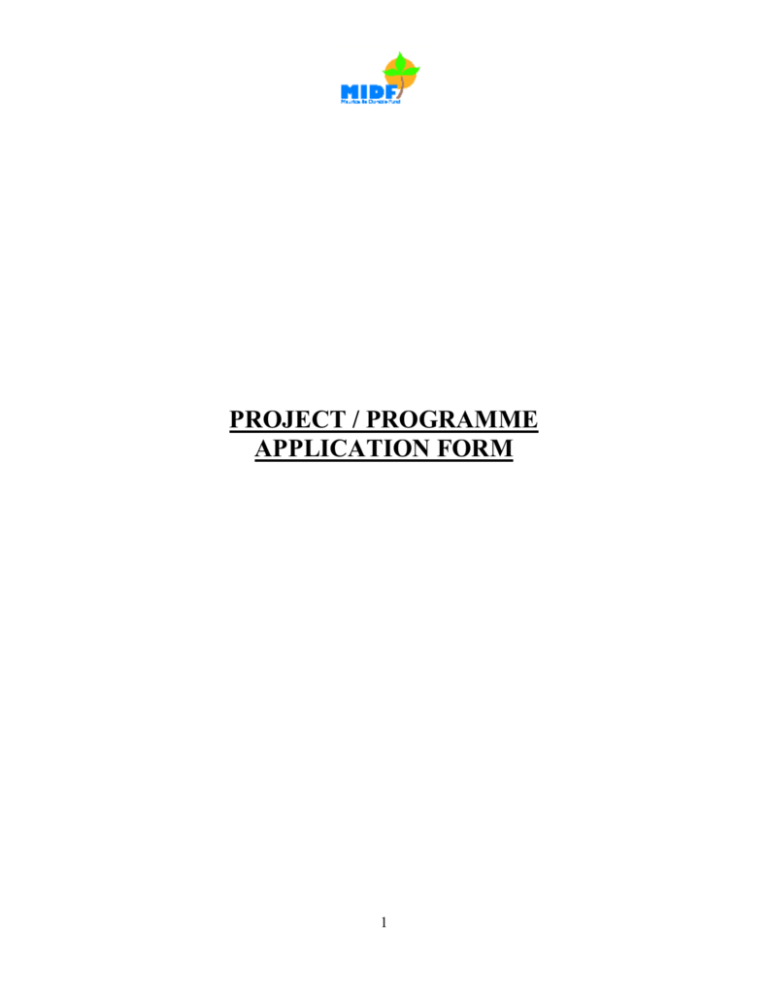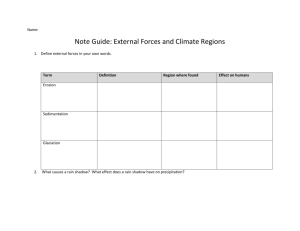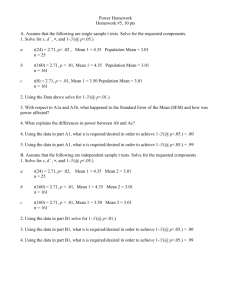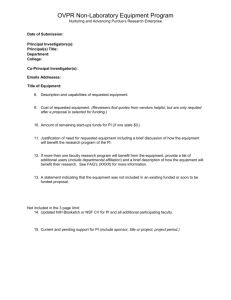MIDF Project Application Form
advertisement

PROJECT / PROGRAMME APPLICATION FORM 1 DATE OF RECEIPT: MID FUND REF PROJECT ID: (For MID PMU Use Only) PROJECT/PROGRAMME PROPOSAL PART I: PROJECT/PROGRAMME INFORMATION Name of Applicant: Contact Person: Postal Address: Position: Telephone No.: Fax No.: E-mail Address: Web Address: Telephone No.: Fax No.: Submission Date: Please indicate which focus area you are applying under: Energy / Resources Environment Education Equity Employment Name of project: Project Timeframe. Start (Month/Day/Year): Project Timeframe. End (Month/Day/Year): Amount requested (in Rupees): Rs Total Project Cost (in Rupees): Rs Fund requested (in Rupees): Rs Co-Financing Amount (if any): Rs Total Project Cost (in Rupees): Rs Implementing Entity Beneficiary(ies) / Target(s) of the project: Which communities, groups or individuals will the project benefit? What are the environmental benefits you anticipate and how do you plan to measure them? Please specify the nature / focal area of the project: Household / Regional / National Commercial / SMEs / Industrial / Tourism / NGOs / Others (specify) Energy Savings/ Energy Efficiency/ Renewable Energy/ Sensitization/ Small Power Producers 2 ORGANIZATIONAL BACAKGROUND: Provide brief summary of organization history, including the date your organization was established Brief summary of organization mission and goals Brief description of organization’s current program or activities, including any service statistics and strengths or accomplishments. Please highlight new or different activities, if any, for your organization PROJECT / PROGRAMME BACKGROUND AND CONTEXT: Provide brief information on the problem the proposed project/programme is aiming to solve. Outline the economic social, development and environmental context in which the project would operate. PROJECT / PROGRAMME OBJECTIVES: List the main objectives of the project. 3 PROJECT / PROGRAMME COMPONENTS AND FINANCING: Fill in the table presenting the relationships among project components, activities, expected concrete outputs, and the corresponding budgets. If necessary, please refer to the attached instructions for a detailed description of each term. For the case of a programme, individual components are likely to refer to specific sub-sets of stakeholders, regions and/or sectors that can be addressed through a set of well defined interventions / projects. This section should also provide a statement of the total cost of the project, a detailed cost breakdown, the amount of fund requested from MID Fund, how these funds are to be used and the amount, status and sources of additional funding, if any. PROJECT COMPONENTS EXPECTED CONCRETE OUTPUTS EXPECTED OUTCOMES 1. 2. 3. 4. 5. 6. Project/Programme Execution cost 7. Total Project/Programme Cost 8. Project Cycle Management Fee charged by the Implementing Entity (if applicable) Amount of Financing Requested Annex 1 provides sample format of the budget and cost for setting up a project. PROJECTED CALENDAR: Indicate the dates of the following milestones for the proposed project/programme MILESTONES Start of Project/Programme Implementation EXPECTED DATES Mid-term Review (if planned) Project/Programme Closing Terminal Evaluation Annex 2 provides sample format of the work and Annex 3 provides sample project schedule. 4 AMOUNT (RUPEES) PART II: PROJECT / PROGRAMME JUSTIFICATION 1. Describe the project / programme components, particularly focusing on the concrete objectives of MID Fund (for objectives, please refer to the Maurice Ile Durable Fund website http://www.gov.mu/portal/sites/mid/index.html) and how these activities contribute to transform the environmental, economic and social landscape of the country. For the case of a programme, show how the combination of individual projects will contribute to the to make Mauritius a world model of sustainable development, particularly in the context of SIDS (Small Island Developing States). 2. Describe how the project / programme provides economic, social and environmental benefits, with particular reference to the most vulnerable communities. 3. Describe or provide an analysis of the cost-effectiveness of the proposed project / programme. 4. Describe how the project / programme is consistent with national or sub-national sustainable development strategies, including, where appropriate, national or sub-national development plans, poverty reduction strategies, national communications, or any national environmental programs of action, or other relevant instruments, where they exist. 5. Describe how the project / programme meets relevant national technical standards, where applicable. 6. Describe if there is duplication of project / programme with other funding sources, if any. 7. If applicable, describe the learning and knowledge management component to capture and disseminate lessons learned. 8. Describe the consultative process, including the list of stakeholders consulted, undertaken during project preparation. 9. Provide justification for funding requested, focusing on the full cost of MID Fund reasoning. 5 PART III: IMPLEMENTATION ARRANGEMENTS A. Describe the arrangements for project / programme implementation. B. Describe the measures for financial and project / programme risk management. These should include both internal factors (e.g. the technology involved fails to work as projected) and external factors (for e.g. currency rate fluctuations, changing economics of the project). You should also include any local conflict of interest identified and explain how you propose to address this issue. Risk identified Likelihood of occurrence (almost certain, likely, possible, unlikely, rare) Consequence of occurrence (negligible, minor, moderate, major, catastrophic) Actions to manage risk C. Describe the monitoring and evaluation arrangements and provide a list of key performance indicators of the project activities in a M&E plan (if any). D. Include a results framework for the project proposal, including milestones, targets and indicators. There should be a clear and direct linkage between the activities and the outcomes. Activity descriptions should be as specific as possible, identifying what will be done, who will do it and where it will be done. A implementation schedule of the activities would be a plus. 6 PART IV: ENDORSEMENT BY MINISTRY OF ENVIRONMENT & SUSTAINABLE DEVELOPMENT AND CERTIFICATION BY THE IMPLEMENTING ENTITY A. RECORD OF ENDORSEMENT ON BEHALF OF THE GOVERNMENT of the government official and indicate date of endorsement. (Enter Name, Position, Ministry) Provide the name and position Date: (Month, day, year) B. IMPLEMENTING ENTITY CERTIFICATION Provide the name and signature of the Implementing Entity Coordinator and the date of signature. Provide also the project/programme contact person’s name, telephone number and email address I certify that this proposal has been prepared in accordance with guidelines provided by the Ministry of Environment & Sustainable Development - MID Fund and subject to the approval by MID Fund Committee, understands that the Implementing Entity will be fully (legally and financially) responsible for the implementation of this project/programme. Name & Signature Implementing Entity Coordinator Date: (Month, Day, Year) Project Contact Person: Tel. And Email: Tel. and email: 7 INSTRUCTIONS FOR PREPARING A REQUEST FOR PROJECT OR PROGRAMME FUNDING FROM THE MAURICE ILE DURABLE FUND Project and programme applications must be clear on the problem to be addressed, the objective(s), what the project/programme will deliver when, how and by whom. Clear baselines, milestones, targets and indicators should be included to ensure progress and results can be measured. Programmes will generally be more complex and will require greater oversight and management which should be properly explained under Implementation Arrangements for programmes. DATE OF RECEIPT. Please leave this space on the top right of the page blank. The Maurice Ile Durable Fund will fill in the date on which the proposal is received at the PMU. MAURICE ILLE DURABLE FUND PROJECT ID. Please leave this space on the top right of the page blank. The PMU will assign a number to your project internally. PART I: PROJECT / PROGRAMME INFORMATION CATEGORY: Please specify which focus area you are proposing. The five options are: 1. Energy / Resources 2. Environment 3. Education 4. Equity 5. Employment A programme will generally fulfil the following criteria: A series of projects which could include smallsize projects or regular projects aimed at achieving an outcome that is otherwise not achievable by a single project. Projects under a programme would have synergies in their objectives and implementation. A programme may also cover more than one sector and cross borders. Programmes usually engage multiple partners / stakeholders. TITLE OF PROJECT / PROGRAMME: Please enter the title of the proposed project / programme. NAME OF IMPLEMENTING ENTITY: Please specify the name of the Implementing Entity AMOUNT OF FINANCING REQUESTED. Please fill the grant amount (in rupees equivalent) requested from the MID Fund for this proposal. PROJECT / PROGRAMME BACKGROUND AND CONTEXT. Provide brief information on the problem the proposed project is aiming to solve. Outline the economic, environmental and social development context in which the project would operate. For the case of a programme, the analysis will be more complex, 8 focusing on how climate change is expected to affect multiple stakeholders, sectoral and/or economic activities within a well defined region. PROJECT / PROGRAMME OBJECTIVES. List the main objectives of the project. For the case of a programme, this is likely to involve multiple objectives by stakeholder / sector / region, based on an overall strategic plan at the regional, national or local level. PROJECT / PROGRAMMES COMPONENTS AND FINANCING. Please fill out the table presenting the relationships among project components, activities, expected concrete outputs, and their corresponding budgets to accomplish them. For the case of a programme, individual components are likely to refer to specific sub-sets of stakeholders, regions and/or sectors that can be addressed through a set of well defined interventions / projects. The aforementioned terms are defined below to facilitate the process of completing the table: PROJECT / PROGRAMME COMPONENTS. The division of the project/programme into its major parts; an aggregation of set of activities ACTIVITIES. Actions taken or work performed through which inputs, such as funds, technical assistance and other types of resources are mobilized to produce specific outputs. For the case of programmes, list the likely types and number of projects that the programme will support MILESTONES / TARGETS. Milestones help with regular monitoring of progress towards the target. Targets indicate the desired result at the end of the project. INDICATORS – What is going to be measured? EXPECTED CONCRETE OUTPUTS. The product, capital goods and services which result from a development intervention relevant to the achievement of outcomes. EXPECTED OUTCOMES. The change in conditions, or intended effects of an intervention, usually brought about by the collective efforts of partners. Outcomes are achieved in the short to medium term. AMOUNT ($). Indicate grant amounts in Mauritian Rupees by project/programme components. TOTAL PROJECT / PROGRAMME COST. This is the sum of all project/programme components requesting MID Fund PMU approval. AMOUNT OF FINANCING REQUESTED. This amount includes the total project cost PROJECTED CALENDAR. Please indicate the dates of the following milestones for the proposed project. START OF PROJECT / PROGRAMME IMPLEMENTATION The date on which project becomes effective and disbursement can be requested. This is also the trigger date for the MID Fund to allow the Implementing Entities to request for disbursement. 9 MID-TERM REVIEW. The date on which the Implementing Entity completes its mid-term review of the project. PROJECT / PROGRAMME CLOSING. Project closing is set as six months after Project Completion. This is the date on which Implementing Entity completes disbursement from the grant and may cancel any undisbursed balance in the grant account. TERMINAL EVALUATION. The date on which the Implementing Entity completes the terminal evaluation report, normally two months after project completion but in any case, no later than twelve months after project completion. PART II: PROJECT / PROGRAMME JUSTIFICATION A. Describe the project / programme components, including details of activities in each component, regarding how the components will meet project objectives. Describe how the activities will help to achieve the MID objectives. For the case of a programme, show how the combination of individual projects will contribute to the overall objective of the MID Fund. B. Describe how the outputs and outcomes of the project / programme will provide economic, social and environmental benefits, particularly to the most vulnerable communities in the targeted area. C. How is the project / programme cost-effective. Compare to other possible interventions that could have been taken to achieve similar project objectives. D. Describe how the project / programme is located in the framework of national development strategies, plans, action plans, etc. E. Describe how the project / programme design meets national technical standards. F. Describe if the project / programme overlaps or duplicates similar activities from other funding sources. G. Describe the activities included in the project / programme to gather lessons learned from project design and implementation and for their dissemination. H. Describe the consultative process undertaken during project design. List the stakeholders consulted and the methods of consultation. I. Provide the full cost of MID reasoning for the funding requested for the project / programme. 10 PART III: IMPLEMENTATION ARRANGEMENTS. Describe the various elements of project implementation as enumerated below: A. Adequacy of project / programme management arrangements. For the case of a programme, explain how the programme strategy will be managed and evaluated, and how individual projects will be identified, designed, appraised, approved, implemented and evaluated against programme’s strategic objectives. Provide a full organization structure of the executing agents and how they report to each other. B. Measures for financial and project / programme risk management. For the case of a programme, provide detailed information to illustrate how risk will be managed. C. Monitoring and evaluation arrangements including budgeted M&E plan. D. Results framework. Guidance and a template for a Results Framework will be provided. PART IV: ENDORSEMENT BY THE DESIGNATED GOVERNMENT AUTHORITY FOR MID FUND AND CERTIFICATION BY THE IMPLEMENTING ENTITY 9. RECORD OF ENDORSEMENT BY DESIGNATED GOVERNMENT AUTHORITY. Provide the name, position, and government office of the designated government authority and indicate date of endorsement. 10. IMPLEMENTING ENTITY CERTIFICATION. Provide the name and signature of the Implementing Entity Coordinator and the date of signature. Provide also the project contact person’s name, telephone number and email address. 11 ANNEX 1: BUDGET FORMAT Organization: MIDF GRANT FUNDING Total Grantee Project Project Title: Other Project Costs MID Fund Project Grant Contributions Contributions (For Service Period) Request (As Needed) TASK 1 TASK 2 TASK 3 TASK 4 TASK 5 Planning Design Construction Project Management Etc [NOTE: Specific tasks at discretion of Grantee, however, tasks should directly tie to Appendix A.] Personnel Services: Salary Salary Salary Benefits % Hourly Employee (Classification/Title) Salaries + Benefits Rate Rate Hours Amount Amount Amount Rs - Rs - Rs - Rs - Rs - Rs - Rs - Rs - Rs Rs - Rs - - Rs - Rs - Indirect Overhead Limited to 10% of Salary + Benefits Rs Salary Indirect Grant + Benefits Overhead Qualified Amount Limit Overhead - 10% Rs - Rs - Land Acquisition Unit Cost Unit of Measure No. of Units Amount Rs - Rs - Rs - Rs - Rs - Rs - Rs - Rs - Rs - Rs - Rs - Rs - Rs - Design Unit Cost Unit of Measure No. of Units Amount Rs - Rs - Rs - Rs - Rs - Rs - Rs - Rs - Rs - Construction Unit Cost Unit of Measure No. of Units Amount Rs - Rs - Rs - Rs - Rs - Rs - Rs - Rs - Rs - Rs - Rs - Other Costs Please Describe: Grand Totals Unit Cost Unit of Measure No. of Units Amount Rs - Rs - Rs - Rs - Rs - Rs - Rs - Rs - Rs - Rs - 12 Rs - Rs - Rs - Rs - Rs - Rs - Annex 1: Sample of Cost Estimate of a Project Estimate of Material Costs Material Cost Solar Panels Mounting Structure Installation Labor Power Electronics (development and parts) Installation Supplies (wire, manual disconnect, circuit breaker) Posters and Documents LCD Display Total Rs 000 Estimate of Labour Costs Person Hourly Rate Hours Total A B C Rs 000 Total 13 Annex 2: Workplan Sample and Implementation Schedule Task Duration Defining and Planning days Identify Need Complete Project Definition Define Requirements Perform Market Research Map Project Schedule Determine Budget Fundraising Write Proposal Solicit Funds Documenting and Reporting Write Draft Project Plan Write Final Project Plan Detailed Design Perform Analysis Select Components Draw Schematic Create Preliminary Design Detailed Design Perform Analysis Select Materials Finalize Drawings Create Draft Design and Presentation Prepare Draft Design Review Present Design Review Design Project Poster Write Draft Final Report Write Final Report Designing Write User Manual Building Prototype Purchase Components Test and Debug Hardware & Software Install Completed System 14 Start Date Finish Date Annex 3: Sample Implementation Schedule Sample Work Schedule Weeks Tasks Month 1 Month 2 Month 3 Inception and Preparation Inception meeting Data collection Stakeholder interviews Assessment and Analysis Assessment of legal frameworks and institutions Assessment of technical and economic constraints Analysis of product lifecycle Analysis of cost-benefit Economic and environmental impact assessment Assess the current model and alternate technology Consolidation, Drafting and Presentation Development of draft strategic options Drafting of Interim Report Presentation of key findings □ Finalisation □ □ Finalisation of study Reports and Deliverables ■ Submission of Inception Report Submission of Interim Report Presentation of findings Submission of Final Report ■ ■ ■ 15






